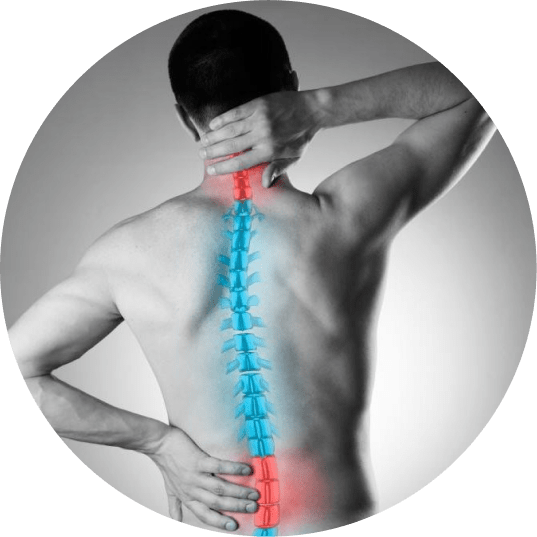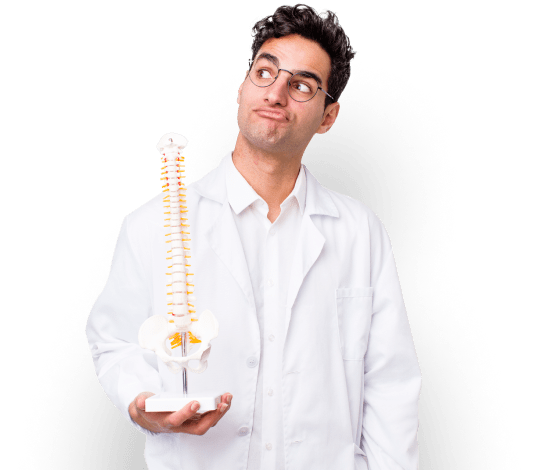Your healthy spine and fresh mind is always our priority!
Spine TB Treatment in Ahmedabad
What is Spine Tuberculosis?
Spine tuberculosis, also known as Pott’s disease or tuberculous spondylitis, is a form of tuberculosis (TB) that affects the spine. It is caused by the bacterium Mycobacterium tuberculosis, the same organism that causes pulmonary tuberculosis.
Spine tuberculosis typically occurs when the tuberculosis bacteria spread from other parts of the body, such as the lungs, through the bloodstream or lymphatic system and infect the vertebrae of the spine. It primarily affects the thoracic (upper back) and lumbar (lower back) regions of the spine.

Symptoms of spine tuberculosis may include
- Back pain, which can be persistent and worsen over time.
- Stiffness or limited mobility of the spine.
- Kyphosis, a forward curvature of the spine resulting in a hunched-back appearance.
- Neurological symptoms such as weakness, numbness, or tingling in the arms or legs if the infection compresses the spinal cord or nerves.
Diagnosis of spine tuberculosis typically involves a combination of imaging tests such as X-rays, CT scans, or MRI scans to visualize the affected area of the spine, as well as laboratory tests such as a tuberculin skin test (TST) or interferon-gamma release assay (IGRA) to detect the presence of tuberculosis bacteria.
Treatment of spine tuberculosis usually involves a prolonged course of anti-tuberculosis medications (antibiotics) taken for several months to years, depending on the severity of the infection. Surgery may be necessary in some cases to remove abscesses, stabilize the spine, or correct deformities caused by the infection.
Early diagnosis and treatment of spine tuberculosis are crucial to prevent complications such as spinal deformities, neurological deficits, and permanent disability. Prompt medical attention should be sought if symptoms suggestive of spine tuberculosis are present.
When and how spine tuberculosis surgery is performed?
Surgery for spine tuberculosis (Pott’s disease) is considered in cases where there is:
- Failure of medical treatment: If anti-tuberculosis medications (antibiotics) fail to control the infection or if there is a risk of neurological complications despite treatment.
- Spinal instability: If the infection causes severe destruction of the vertebrae leading to spinal instability, which can result in deformity, compression of the spinal cord, or nerve roots.
- Large abscesses: If there are large abscesses (collections of pus) that need to be drained to relieve pressure on the spinal cord or nerves.
- Progressive deformity: If the infection leads to kyphosis (forward curvature of the spine), which may progress and cause significant disability.
- Failed conservative management: If conservative measures such as immobilization, medication, and physical therapy fail to alleviate symptoms or control the progression of the disease.
Surgery for spine tuberculosis may involve different procedures depending on the severity and location of the infection, as well as the presence of complications. Some common surgical techniques used in the management of spine tuberculosis include:
- Decompression and debridement: The surgical removal of infected tissue, bone, and abscesses to relieve pressure on the spinal cord and nerve roots.
- Spinal fusion: The fusion of adjacent vertebrae using bone grafts, metal plates, screws, or rods to stabilize the spine and prevent further deformity.
- Abscess drainage: The surgical drainage of abscesses to reduce pressure on the spinal cord or nerves and to remove infected fluid and tissue.
- Kyphosis correction: Surgical correction of kyphosis (forward curvature of the spine) using techniques such as osteotomy (cutting and realigning the bones) or spinal instrumentation (metal implants) to restore spinal alignment.
- Vertebrectomy: The surgical removal of one or more vertebrae affected by tuberculosis, followed by spinal fusion to stabilize the spine.
The timing of surgery for spine tuberculosis depends on factors such as the severity of symptoms, the extent of spinal involvement, the response to medical treatment, and the presence of complications. Surgery may be performed as soon as the diagnosis is made in severe cases or may be delayed until after a course of anti-tuberculosis medication in less urgent situations. The decision to undergo surgery and the choice of surgical technique should be made in consultation with a spine surgeon experienced in the management of spine tuberculosis.
Our Spine TB Treatment Doctor

Dr. Nisarg Parikh
M.B.B.S. & MS in Orthopaedics ( Spine Surgeon and pain specialist )
Dr. Nisarg Parikh completed his M.B.B.S. and MS in Orthopedics from prestigious Smt. N.H.L. Medical college, V.S. Hospital. After working as an assistant professor in department of orthopedics in same institute he started his career in field of Spine Surgery. He completed rigorous spine training from ace spine institutes from India, Italy and Germany. He was awarded AO Spine Fellowship as well.
2019 March marked the beginning of Swasti Spine and Mind Care, his long-cherished dream of holistic Spine Centre.
Till date he has performed more than 5000 successful spine surgeries. He has presented and published several research papers in national and international conferences and won medals for many presentations. He has co-authored chapters in spine textbook and has been invited as faculty in many spine conferences across India.
Currently he holds position of Director and Consultant Spine Surgeon at Swasti Spine and Mind Care, Ahmedabad. At Sheth. L.G. Hospital and Dr. Jivaraj Mehta Hospital he is serving as an honorary spine surgeon.

Spine & Mind Health
Total Wealth

Why choose us?
We leave no stone unturned when it comes to patient care, safety and advanced treatments. Come! Experience the Swasti Care and relive a healthy life!


24 X 7 Professional Care


Best Living Conditions


Daily Assistance


Individualized Care


Psychotherapy Unit


Social Activities


Latest Technology
Our patient's healing experience
“ My name is Sajay Panchal and I am 39 years. I had suffering severe Back pain and many problems of Spine. But thanks for Dr. Nisarg Parikh(Spine surgeon). Before 2 days successfully done my surgery by Dr. Nisarg Parikh sir. And now I am fine and all well. Now no any complain of my spine. So once again thank u so much Dr Nisarg Parikh.“
“ My mother suffering of spine issue, Dr Nisarg treated her extremelly well. My mother is much better now, she started walking from very next day. Very supportive staff, physiotherapist is always available for help, neat and clean rooms. Highly recommended for spine related issues.“
“ My name is Loreen Danstone Lyimo from Tanzania.I had spinal problem,I got the best treatment done by DR Nisarg Parikh,the hospital gives the best service,workers are good ,lovely and caring.I thank my God that I am now OK. God bless you all. Thank you Dr.Nisarg parikh sir. Really best spine surgeon in Gujarat.“
“ My grandmother had undergone a major spine surgery performed by Dr. Nisarg Parikh. The surgery was successfully executed and we are obliged by the results and the experience. The staff here is extremely skilled and cooperative and the facility is state of the art. Highly recommended.“
“ Dr Nisarg Parikh sir is very humble and intelligent spine surgeon in the town. I personally assisted him in many spine surgeries during my residency phase and today Im happy to say that he did best for my uncle and now he is recovering from his condition. Thank you Swasti Spine and Mind Care Hospital.“
Our patient's healing experience with live words
shyamal :
503, Golden Icon, Nr Someshwar Jain temple Cross Rds, 132 Feet Ring Rd, nr. Shyamal, Ahmedabad, Gujarat 380015
contact us
Take the first step towards a healthy life!



